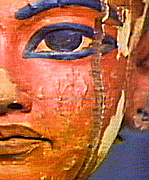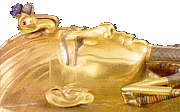
Volume 1 Number 14
September 15, 1995


|
The Face of Tutankhamun
Episode One: ``The Great Adventure."
Arts & Entertainment Network. 49 minutes.
Distributed as part of the Cable in the Classroom project: 7
- 8 a.m. Eastern time, Friday, September 29th. (Episodes 2 through 5 will be
broadcast at the same time in succeeding weeks.)
Grades 10 - 13 / Ages 14 - Adult.
Review by Duncan Thornton.
|
exerpt:
From the discovery of the fantastic burial place of
Tutankhamen to a sparsely attended funeral in South London, the career of
archaeologist Howard Carter was one of stark contrasts -- between high
adventure and deep disappointment; between fame and neglect; a blessing
and a curse.
 This is the first part of Cable in the Classroom's presentation of the
A&E series on King Tut, The Face of Tutankhamun, hosted by the
genial and amusing professor Christopher Frayling.
This is the first part of Cable in the Classroom's presentation of the
A&E series on King Tut, The Face of Tutankhamun, hosted by the
genial and amusing professor Christopher Frayling.
Like APEMAN (reviewed here this week and last), and
most A&E materials, it is smoothly made and attractively filmed, and the
story of the young king, and how his tomb was found is as fascinating as
any in archaeology. But this first episode will really hold the
attention only of those already caught by the Tut mystique: it's largely an
account of everything in the career of Howard Carter, the archaeologist
who made the great discovery, right up to the point when the door
is opened.
So it might be smarter to wait to use this one for a resource after
showing later episodes that get into the meat of the find, or after using
other projects or curriculum items to whet the appetite for Egyptology.
But for an interested audience, this has plenty of good material. (It's
interesting, for example, to find that as a boy Carter was friends with
Lord and Lady Amherst, whose home, Didlington, held the largest
collection of Egyptian relics in England; thus Carter was practiced at
observing and drawing Egyptian artifacts before he ever left England.)
And there are good asides, like the difference between ancient tomb robbers -- who ruined so many potential finds
-- who were interested precious metals, and modern tomb robbers, who are primarily interested in stealing ancient Egyptian art, for which there's a ready market. Of
course the Tut find was to hold both art and gold in abundance, though the question of
whether breaking into a someone's grave and despoiling it is really all
right just as long as, like Indiana Jones, you cry ``It belongs in a
museum!" is left unasked.

But there's an awful lot of detail about the early archaeological
career of Carter, a man with a good eye and a chip on his shoulder. More
about the politics between the early twentieth-century French and English administrations in
Egypt than we really want to know, and more details about Carter's
early patrons, or more about how exactly he managed to climb into one of
the tombs he discovered before the great find of Tut.
So it's a long wait before we reach the climax of this episode, and
the start of what should be the really fascinating stuff, the thrilling
moment Carter recorded:
At first I could see nothing; the hot air escaping from
the chamber caused the candle flame to flicker. But presently, as my eyes
grew accustomed to the light, details of the room within emerged slowly
from the mist -- strange animals, statuettes, and gold! Everywhere, the
glint of gold!
Recommended, with reservations.
Duncan Thornton is the Editor of Canadian Materials.

Copyright © 1995 the Manitoba Library Association.
Reproduction for personal use is permitted only if this copyright notice is
maintained. Any other reproduction is prohibited without permission.
Published by
The Manitoba Library Association
ISSN 1201-9364
 Go back to CM Welcome page
Go back to CM Welcome page
 Go back to Table of
Contents for this Issue
Go back to Table of
Contents for this Issue



 This is the first part of Cable in the Classroom's presentation of the
A&E series on King Tut, The Face of Tutankhamun, hosted by the
genial and amusing professor Christopher Frayling.
This is the first part of Cable in the Classroom's presentation of the
A&E series on King Tut, The Face of Tutankhamun, hosted by the
genial and amusing professor Christopher Frayling.